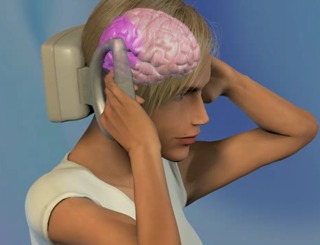A magnetic cranial stimulator has been approved by the U.S. Food and Drug Administration as an effective means of treatment for those suffering from migraines.

The device, referred to as the Cerena Transcranial Magnetic Stimulator (CTMS), eases the pain of headaches preceded by aura, the sensory disturbances that happen right before a migraine begins. To operate it, a patient simply holds the device against the back of their head and presses a button; doing this releases a short pulse of magnetic energy, which stimulates the brain’s occipital cortex and stops – or otherwise eases – the developing migraine pain.

A bit more scientifically, when applied to the back of the head, a very short magnetic field passes through the skull and tissue, non-invasively and without causing any sort of discomfort. This field induces very mild electrical currents in the brain tissue to excite and depolarize neurons in the brain. It is believed that this specific process interrupts the abnormal electrical activity associated with migraine and cortical spreading depression.
Developed by eNeura Therapeutics of Sunnyvale, CA, the CTMS’s approval is based on a trial involving 201 patients who suffered moderate to strong migraine with aura. 113 of the patients tried treating their migraines with the CTMS while an attack was in progress; the group’s positive response to the device’s effectiveness is what ultimately led to the FDA’s approval.
A further breakdown of the numbers show that 38% of those using the stimulator said they were pain-free two hours later, as opposed to 17% who did not use the device. A full day later, 34% of those who used the CTMS said they were completely pain-free, compared to 10% of those who hadn’t used the device.
“The Cerena TMS is another tool in the battle to relieve migraines,” said Dr. Mark Green, director of Headache and Pain Management at New York City’s Mount Sinai Medical Center. “Experience with TMS over the past few years have shown that these agents have the potential to reduce the pain of an attack without the use of medications, or in addition to medical treatment.”
Dr. Noah Rosen is director of the Headache Center at North Shore-LIJ's Cushing Neuroscience Institute, in Manhasset, NY. He said that, “although only 20% of migraneurs suffer from an aura associated with their headaches, they suffer significantly. Although this device is unwieldy, it may be a preferred choice by those who don't want [drug] treatment.”
Though side effects were rare, there were a handful of reports, including sinusitis, aphasia, and vertigo.
The new device is approved for use by adults 18 and older only. Other stipulations include: It shouldn’t be used by anyone with suspected or diagnosed epilepsy, a family history of seizures, metal device implanted in the head, neck or upper body, or by people with “an active implanted medical device such as a pacemaker or deep brain stimulator,” the FDA said.
Additionally, it’s not meant to be used more than once every 24 hours.
The Cerena Transcranial Magnetic Stimulator is available via prescription only.
Story via consumer.healthday.com
Advertisement
Learn more about Electronic Products Magazine





